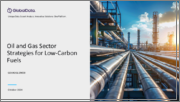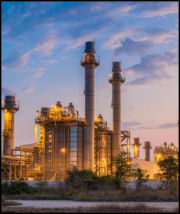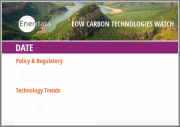
|
시장보고서
상품코드
1590531
석유 및 가스 부문의 저탄소 연료 전략Oil and Gas Sector Strategies for Low-Carbon Fuels |
||||||
석유 및 가스 산업은 정부와 투자자들로부터 탈탄소화 및 제품 다양화에 대한 압력을 받고 있습니다. 재생 디젤, SAF, 합성 연료와 같은 저탄소 연료는 석유 및 가스 산업이 기존 소비재 산업에 제품과 서비스를 계속 제공하면서 자산을 다양화하고 인프라 노후화 위험을 줄이는 탈탄소화의 길을 열어줄 수 있습니다.
석유 및 가스 산업은 현재 많은 문제에 직면해 있지만, 탈탄소화 및 제품 다양화에 대한 압력은 가장 큰 도전입니다. 이는 기후 변화에 대한 우려와 정부의 탄소세 인상으로 인해 석유 및 가스 기업의 이익을 위협하고 있기 때문입니다. 이러한 압력은 산업의 장기적인 수익성을 우려하는 투자자들로부터의 압력이기도 합니다. 실제로 세계경제포럼(World Economic Forum)은 석유 수요가 2030-2035년에 정점을 찍을 것으로 전망하고 있습니다.
재생가능 디젤, SAF 및 합성 연료와 같은 저탄소 연료는 석유 산업이 기존 소비재 산업에 제품과 서비스를 계속 제공하는 동시에 자산을 다양화하고 인프라 노후화 위험을 줄일 수 있는 탈탄소화 경로를 제공합니다.
석유 및 가스 기업들이 저탄소 연료 시장에 진입하기 위해 모색하고 있는 전략은 여러 가지가 있습니다. 그 중 하나는 코프로세싱을 통한 재생가능 디젤 및 SAF 생산, 또는 기존 설비를 재사용하여 기존 정유소를 전환하는 것입니다. 또 다른 방법은 재생 가능 독립형 정유소에 대한 장기적인 투자입니다. 이 정유소는 초기 투자비용이 더 많이 들지만, 코프로세싱 정유소나 전환 정유소보다 훨씬 더 높은 생산 능력으로 생산 규모를 확장할 수 있습니다.
재생가능 독립형 프로젝트는 재생가능 디젤과 SAF 생산 능력의 대부분을 차지하며, 2030년 전체 재생에너지 정유소 생산 능력의 64%를 차지할 것으로 예상됩니다. 한편, 석유 및 가스 회사는 합성 연료를 생산하기 위해 수소 공급업체와 협력하거나 자체 수소 생산 시설에 투자해야 합니다.
이러한 저탄소 연료의 생산량은 각각 증가할 것으로 예상되지만, 현재로서는 기존 연료에 비해 비용 경쟁력이 떨어진다는 문제가 있습니다. 또한 최근 화석연료 수요의 급격한 증가로 인해 석유 및 가스 기업들은 산업 수명에 대한 자신감이 높아져 저탄소 연료에 대한 투자가 최근 몇 년동안 둔화되었습니다.
전체적으로 SAF는 2020-2035년 연평균 44%의 생산량 증가로 가장 강력한 성장세를 보이며 석유 및 가스 산업에서 유망한 개발 분야가 될 것으로 보입니다. 반면, 재생가능 디젤의 생산능력은 일부가 SAF로 전환됨에 따라 같은 기간 동안 9%의 연평균 복합 성장률(CAGR)에 그칠 것으로 예상됩니다. 재생가능 디젤은 수요 감소로 인해 향후 10년간 공급과잉에 직면할 가능성이 있습니다. 마지막으로, 생산상의 문제로 인해 2030년까지 석유 및 가스 기업이 가장 선호하지 않는 재생 가능 연료는 합성 연료가 될 것으로 보입니다.
주요 하이라이트
- 3가지 유형의 재생 가능 정유소(원유 정제소 전환, 코프로세싱, 재생 가능 독립형)의 생산 능력은 2030년까지 계속 증가할 것으로 예상됩니다.
- 원유 정제소 전환 및 원유 정제 코프로세싱 생산 능력은 모두 2024-2030년간 연평균 14% 성장할 것으로 예상됩니다.
- 재생 가능 독립형 생산 능력은 가장 높은 성장률로 2024-2030년간 CAGR이 30%에 달할 전망입니다.
- 세 가지 유형의 정유소 모두 2024-2030년 사이에 RD가 아닌 SAF로 생산능력이 이동하는 것을 볼 수 있습니다.
- RD의 생산과 소비는 2020-2032년간 각각 연평균 12%, 12.5%의 성장률을 보이며 정점에 도달할 것입니다.
- 세계 SAF 생산 및 소비는 2020-2035년간 연평균 44% 성장할 것으로 예상됩니다.
- 저탄소 수소를 이용한 합성연료 생산은 2025-2030년 연평균 58% 성장하고, 2030년에는 생산능력이 급증(연간 1,000만 톤 이상)할 것으로 예상됩니다.
이 보고서는 세계 석유 및 가스 산업에 대한 조사 및 분석, 저탄소 연료 전략, 바이오연료 관련 법적 프레임워크, 각 재생 가능 연료 시장 전망 등의 정보를 제공합니다.
목차
- 주요 요약
- 바이오연료에 관한 법적 프레임워크
- 재생 연료에의 이동을 향한 부문 전략
- 원유 정유소 전환, 코프로셋싱 vs. 재생 스탠드얼론
- 재생 디젤 : 시장 전망과 리더
- SAF : 시장 전망과 리더
- 합성연료 : 시장 전망과 리더
- 중요 사항
The oil and gas industry is facing pressures from both governments and investors to decarbonize and diversify its products. Low-carbon fuels such as renewable diesel, SAFs, and synthetic fuels offer a route to decarbonization that allows the industry to continue providing products and services to its existing consumer industries, while diversifying its assets and decreasing the risk of its infrastructure becoming obsolete.
The oil and gas industry currently faces numerous challenges, but the pressure to decarbonize and diversify its products is arguably the largest. This is due to climate concerns, as well as increasing carbon tax imposed by governments, which threatens oil and gas companies' profits. This pressure also comes from investors, who are concerned with the long-term profitability of the industry. In fact, the World Economic Forum forecasts oil demand to peak between 2030 and 2035.
Low-carbon fuels such as renewable diesel, SAFs, and synthetic fuels offer a route to decarbonization that allows the industry to continue providing products and services to its existing consumer industries, while diversifying its assets and decreasing the risk of its infrastructure becoming obsolete.
There are a number of strategies that oil and gas players are exploring to branch into the low carbon fuels market. One pathway includes producing renewable diesel and SAFs through coprocessing or the conversion of existing refineries by repurposing existing equipment. Another pathway includes long-term investments into renewable standalone refineries, which require greater upfront capital but can scale production to far higher capacities than co-processing and conversion refineries.
Renewable standalone projects are expected to contribute the bulk of the production capacity for renewable diesel and SAFs, accounting for 64% of the overall renewable refinery capacity in 2030. Meanwhile, oil and gas players will need to engage with hydrogen suppliers or invest in their own hydrogen production facilities to produce synthetic fuels.
The production of each of these low-carbon fuels is expected to increase, but all come with their own set of challenges, namely that they are currently not cost-competitive compared to conventional fuels. A surge in fossil fuel demand in recent years has also led oil and gas companies to gain more confidence surrounding the industry's longevity, leading to a recent slowdown in low-carbon fuel investments.
Overall, SAFs will experience the strongest growth, with production increasing at a CAGR of 44% between 2020 and 2035 and, as a result, represent a promising area of development for the oil and gas industry. Meanwhile, renewable diesel production will increase at a smaller CAGR of 9% across the same time frame, as some of its capacity will be diverted to SAFs. RD may also face oversupply challenges in the next decade, due to a predicted decrease in its demand. Lastly, production challenges will see synthetic fuels as the renewable fuel picked the least by oil and gas companies in the run-up to 2030.
Key Highlights
- Capacities for all three types of renewable refineries (crude oil refinery conversion, coprocessing and renewable standalone) are forecast to keep increasing through to 2030.
- Crude refinery conversion and crude refinery co-processing capacities are both set to grow at a CAGR of 14% between 2024 and 2030.
- Renewable standalone capacity is growing at the highest rate, with a CAGR of 30% between 2024 and 2030.
- For all three types of refineries, between 2024 and 2030, a shift can be witnessed where capacity is increasingly being devoted to SAFs as opposed to RD.
- RD production and consumption are both set to grow at a CAGR of 12% and 12.5%, respectively, between 2020 and 2032, where they are set to reach a peak.
- Global SAF production and consumption are both set to grow at a CAGR of 44% between 2020 and 2035.
- Synthetic fuel production from low-carbon hydrogen is set to keep growing, with a positive CAGR of 58% between 2025 and 2030, with a spike in capacity in 2030 (over 10mtpa).
Scope
- Oil and gas sector strategies for low-carbon fuels;
- Legislative framework for biofuels, with specific focus on RD and SAF;
- Sector strategies for transitioning into renewable fuels, including refinery retrofitting;
- Crude oil refinery conversion and coprocessing vs renewable standalone
- Renewable diesel: market outlook and leaders
- SAFs: market outlook and leaders
- Synthetic fuels: market outlook and leaders
Reasons to Buy
- Identify decarbonizing market trends within the oil and gas sector, including the analysis of the strategies that the biggest industry players are implementing.
- Develop market insight of the major technologies and pathways used to decarbonize the industry, including refinery retrofitting as well as investment into standalone refineries, with focus on renewable diesel, sustainable aviation fuels, and synthetic fuels.
- Identify the key policies driving development and which countries have the most established legislative framework for said technologies.
- Facilitate the understanding of what is predicted to happen in the renewable fuels market within the next decade.
Table of Contents
Table of Contents
- Executive summary
- Legislative framework for biofuels
- Sector strategies for transitioning into renewable fuels
- Crude oil refinery conversion and coprocessing vs renewable standalone
- Renewable diesel: market outlook and leaders
- SAFs: market outlook and leaders
- Synthetic fuels: market outlook and leaders
- Key takeaways












